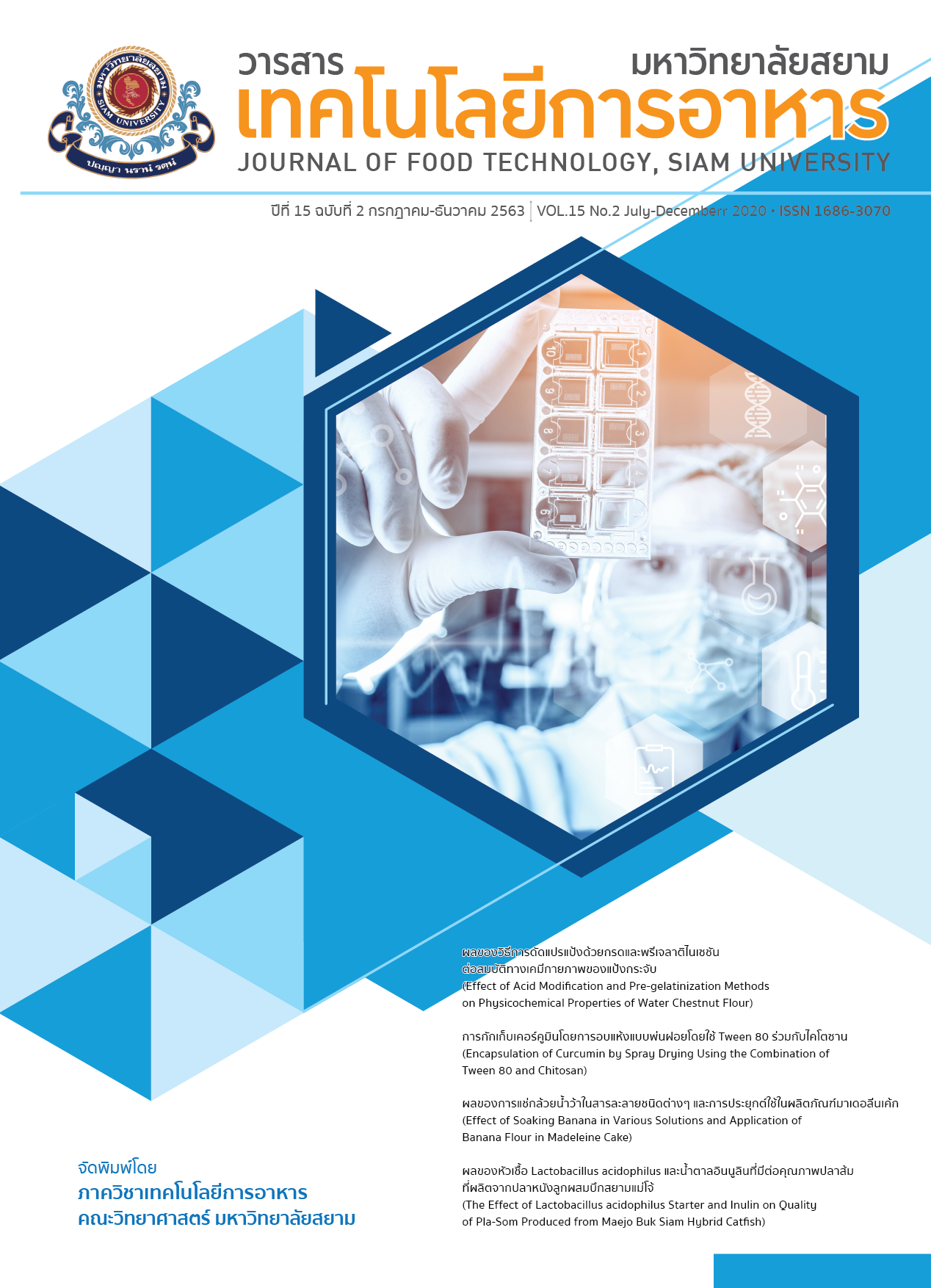ผลของระยะเวลาอบแห้งเยือกแข็งและอุณหภูมิในการคืนตัวต่อคุณภาพของสละแช่อิ่ม
Main Article Content
บทคัดย่อ
งานวิจัยนี้มีวัตถุประสงค์ เพื่อศึกษาผลของระยะเวลาอบแห้งเยือกแข็ง และระดับอุณหภูมิในการคืนตัวต่อคุณภาพของสละแช่อิ่ม โดยใช้แผนการทดลองแบบสุ่มสมบูรณ์ แปรผันระยะเวลาอบแห้งเป็น 5 ระดับ คือ 14, 16, 18, 20 และ 22 ชั่วโมง และแปรผันระดับอุณหภูมิในการคืนตัวเป็น 4 ระดับ คือ 0, 25, 50, และ 75 องศาเซลเซียส จากนั้นนำผลิตภัณฑ์ที่ได้มาตรวจสอบคุณภาพทางกายภาพ เคมี และทางประสาทสัมผัส พบว่า ระยะเวลาที่เหมาะสมที่สุดในการอบแห้งเยือกแข็งของสละแช่อิ่ม คือ 20 ชั่วโมง โดยที่ระยะเวลานี้ทำให้คุณภาพทางกายภาพโดยรวมและคุณภาพทางประสาทสัมผัสด้านกลิ่น รสชาติ เนื้อสัมผัส และความชอบรวม สูงกว่าที่ระยะเวลาอบ 14, 16 และ 18 อย่างมีนัยสำคัญทางสถิติ (p ≤ 0.05) แต่ไม่แตกต่างจากเวลาอบแห้งที่ 22 ชั่วโมง (p > 0.05) เวลาอบแห้งที่ 20 ชั่วโมงจึงมีความเหมาะสมมากกว่าเมื่อพิจารณาด้านต้นทุนการผลิต นอกจากนี้พบว่า สละอบแห้งเยือกแข็งที่ผ่านการคืนตัวที่อุณหภูมิ 25, 50 และ 75 องศาเซลเซียสมีคุณภาพทางกายภาพทุกด้านสูงกว่าการคืนตัวที่อุณหภูมิ 0 องศาเซลเซียส อย่างมีนัยสำคัญทางสถิติ (p ≤ 0.05) ผลการประเมินคุณภาพทางประสาทสัมผัสพบว่า สละอบแห้งเยือกแข็งที่ผ่านการคืนตัวที่อุณหภูมิ 75 องศาเซลเซียส มีคะแนนยอมรับมากที่สุด โดยได้รับคะแนนความชอบอยู่ในระดับชอบปานกลาง
Article Details
บทความทุกบทความในวารสารเทคโนโลยีการอาหาร ทั้งในรูปแบบสิ่งพิมพ์ และในระบบออนไลน์ ถือเป็นลิขสิทธิ์ของมหาวิทยาลัยสยาม และได้รับการคุ้มครองตามกฎหมาย
เอกสารอ้างอิง
Information and Communication Technology Center Department of Agricultural Extension (2017). Salacca. [Online] Available from http://www.agriinfo.doae.go.th/year60/ plant/rortor/fruit2/zalacca1.pdf. (in Thai).
Changprasert, S. (2016). Research and Development for high quality Sala production technology. Department of Agriculture, Ministry of Agriculture and Cooperatives. (in Thai).
Chanthapirak, S., Kantrong, H. and Klongdee, S. (2017). Product development of Crystallized Salacca. Complete research report. Kasetsart University. (in Thai).
Fellows, P.J. (2000). Dielectric, ohmic and infrared heating. pp. 365 – 384. In P.J. Fellows (ed.). Food processing technology: principles and practice. 2nd ed. Woodhead Publishing Limited, Cambridge.
Fennema, O.R., Powrie, W.D. and Marth, E.H. (1973). Low-temperature preservation of foods and living matter. Dekker, New York.
Skrede, G. (1996). Fruits, freezing effects on food quality (Jeremiah LE ed.) Marcel Dekker, NY, USA.
National Agricultural and Food Standards. (2013). SALACCA. National Bureau of Agricultural Commodity and Food Standards Ministry of Agriculture and Cooperatives, Ministry of Agriculture and Cooperatives. (in Thai).
A.O.A.C. (2000). Official Method of Analysis. (16th ed.), Virginia, USA. The Association of Official Analysis Chemists.
Chiralt, A. and Talens, P. (2005). Physical and chemical changes induced by osmotic dehydration in plant tissues. Journal of Food Engineering. 67: 167-177.
Martinez-Valencia, B.B., Abud-Archila, M., Ruiz-Cabrera, M.A., Grajales-Lagunes, A., Dendooven, L.,Ovando-Chacon, S.L. and Gutierrez-Miceli, F.A. (2011). Pulsed vacuum osmotic dehydration kinetics of melon (Cucumis melo L.) var. cantaloupe. African Journal of Agricultural Research. 6(15): 3588-3596.
Thai Industrial Standards Institute. (2015). Thai community product standards: dried fruits and vegetables. TCPS Number.136/2558. (in Thai).
CalForLife. (2020). Calories in Salk, palm, sweet (Salacca, sweet). [Online] Available from https://www.calforlife.com/th/calories/ salak-palm-sweet (in Thai). [Accessed March 16, 2020].
Saphanich, N. (2002). Water activity and controlling the shelf life of food products. Charpa Journal. 9(68): 48-51.
Pornchaloempong, P. and Rattanapanone, N. (2020). Drying method and dryer. [Online] Available from http://www.food networksolution.com/wiki/word/0277/dehydration. (in Thai). [Accessed March 20, 2020].
Yuenyongputtakal, W. (2013). Factors influencing on dewatering by osmotic dehydration of fruits and vegetables. Burapha Science Journal. 18(1): 226-233. (in Thai).
Luh, B.S., and Eidel, L. (1969). Chemical changes in freeze dried mushroom (Agaricus bisporus) Fruchtsafi-Ind .14:58.


